As climate change escalates, property developers are implementing new building standards along Boston’s waterfront to increase their resilience to flooding. But because they are pursuing private interests, these developers are using the greening efforts for marketing materials rather than the entire city’s benefit.
The marketing has been so devastatingly successful that its effects have been nicknamed “greenification.” Fortifying buildings in case of natural disasters incur a significant additional cost, and without government intervention, developers feel free to pass these costs onto the customer. As a result, prices for homes along the waterfront have risen.
This type of insurance is highly attractive to the affluent, and this sort of demand has a similar effect to the higher construction costs. It gives developers the freedom to raise real estate prices, thus forcing out the original residents who can no longer afford to live there.
Protection from human-induced destruction is absolutely everyone’s right. So why has Boston’s government allowed it to be interpreted as something strictly available to the privileged? There is little reason for this besides the fact that Boston is now thought of as a business instead of a city.
Although it is a wealthy city that benefits from capital flows, businesses are ultimately just one part of Boston. It shouldn’t be the other way around. And yet it has become that way because the government will not acknowledge that safety is a public good. It has allowed itself to fall into the trap of instant gratification at the expense of the people who are already living here.
Some have argued that these greening efforts are revitalizing Boston and making it an increasingly desirable place to live. That would be true if they were being applied everywhere, but clearly that isn’t the case. What the proponents of greenification fail to realize is that underpinning their argument is the misconception that Boston is strictly a city for the affluent.
It is reasonable for the developers to capitalize on already affluent neighborhoods, such as Beacon Hill. For areas like East Boston that are historically low-income, immigrant neighborhoods, the burden of protection falls especially hard onto the government.
It won’t matter if you maintain Boston’s nicest and most touristy areas if the rest of the city falls prey to flooding. Developers have little to no incentive to implement these building standards in areas that have low real estate prices.
In the current debate, climate change has increasingly become the burden of the private sector. In that regard, these developers cannot be faulted for charging these higher prices — albeit, they are likely making more profit than necessary. Without government subsidies for rent, living wages or accessibility to higher paying jobs, it is immoral to turn people away from their former homes and force them to live further away from their place of employment.
Given that public transportation gets more sparse the further you get from the main city, it is especially immoral for the government to allow gentrification to proceed in this way. How do you expect people to get to their jobs and pay their taxes?
Of course, it is no small feat to simultaneously address both gentrification and climate change at the same time. But the way that Boston is currently approaching the task is egregious. It is self-evident that the infrastructure agenda is being created with the wealthy and tourists in mind. This isn’t to say that they are not an important part of the local economy. However, they should not be dictating the direction of the agenda to this degree.
Unfortunately, Boston’s government needs to be reminded that it should focus on protecting those who already occupy the space and not those who may or may not move in. So many establishments already exist to support them, and if anything, only permit gentrification to continue there. That is the lesser of two evils.

















































































































